Panaeolina foenisecii
| Panaeolina foenisecii | |
|---|---|
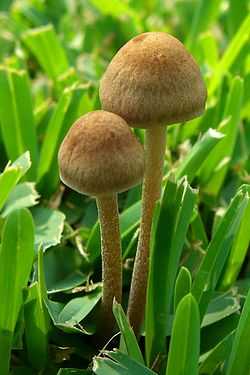 | |
| Scientific classification | |
| Kingdom: | Fungi |
| Division: | Basidiomycota |
| Class: | Agaricomycetes |
| Order: | Agaricales |
| Family: | Bolbitiaceae |
| Genus: | Panaeolina |
| Species: | P. foenisecii |
| Binomial name | |
| Panaeolina foenisecii (Pers.) R.Maire (1933) | |
| Synonyms[1] | |
|
Agaricus foenisecii Pers. (1800) | |
| Panaeolina foenisecii | |
|---|---|
|
| |
| gills on hymenium | |
| cap is convex | |
| hymenium is adnexed | |
| stipe is bare | |
| spore print is blackish-brown | |
| ecology is saprotrophic | |
| edibility: inedible | |
Panaeolina foenisecii, commonly called the mower's mushroom, haymaker or brown hay mushroom, is a very common and widely distributed little brown mushroom often found on lawns. In 1963 Tyler and Smith found that this mushroom contains serotonin, 5-HTP and 5-hydroxyindoleacetic acid.[2] In many field guides it is listed as psychoactive due to psilocybin content, however the mushroom does not produce any psychoactive alkaloids.[3]
It is sometimes mistaken for the psychedelic Panaeolus cinctulus or Panaeolus olivaceus both of which share the same habitat and can be differentiated by their jet black spores. This is probably why Panaeolina foenisecii is often listed as a psychoactive species.
Description
- Cap: 1.5 to 3 cm across, conic to convex, chestnut brown to tan, hygrophanous, often with a dark band around the margin which fades as the mushroom dries.
- Gills: Broad, adnate, brown with lighter edges, becoming mottled as the spores mature.
- Stipe: 4 to 6 cm by 2 to 3 mm, fragile, hollow, white to light brown, pruinose and slightly striate.
- Taste: A slightly unpleasant nutty fungal taste.
- Odor: Nutty, slightly unpleasant.
- Spore print: Dark walnut brown.
- Microscopic features: Spores measure 12 - 17 x 7 - 11 μm, subfusoid to lemon shaped, rough, dextrinoid, with an apical germ pore. Cheilocystidia subfusoid to cylindric or subcapitate, often wavy, up to 50 μm long. Pleurocystidia absent, but some authors report inconspicuous "pseudocystidia". The pileipellis a cellular cuticle with subglobose elements and has pileocystidia. [4]
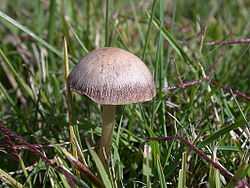
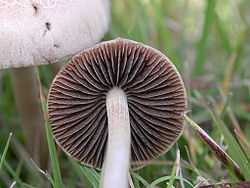
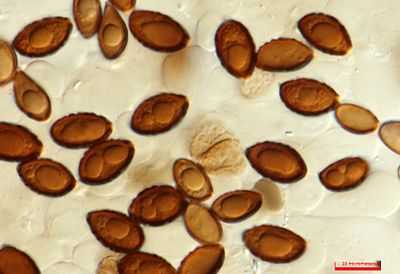
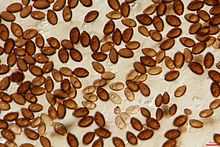
See also
References
- ↑ "Panaeolina foenisecii (Pers.) Maire 1933". MycoBank. International Mycological Association. Retrieved 2012-05-07.
- ↑ Tyler VE, Smith AH. (1963). "Protoalkaloids in Panaeolus species". In Mothes K, Schroter HB (eds). 2 Internationale Arbeitstagung Biochemie und Physiologie der Alkaloide. Berlin, Germany. pp. 45–54.
- ↑ John W. Allen and Mark D. Merlin. "Observations Regarding the Suspected Psychoactive Properties of Panaeolus foenisecii Maire". Retrieved 2012-06-10.
- ↑ "Panaeolus foenisecii (Pers.) Maire 1933". Mushroomexpert.com. Retrieved 2013-03-03.
External links
- Mushroom Expert – Panaeolus foenisecii
- Mykoweb – Panaeolus foenisecii
- Mushroom Observer – Panaeolina foenisecii at mushroomobserver.org
- Rough Spored Panaeoloideae spore comparison
| Wikimedia Commons has media related to Panaeolina. |